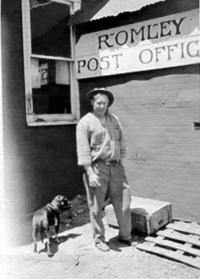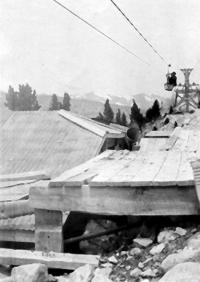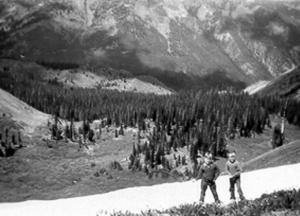Article by Sid Dickinson
St. Elmo – June 2002 – Colorado Central Magazine
IN THE MID AND LATE 1930s my brother and I were two of the luckiest kids in Colorado because we got to spend our vacations in St. Elmo, Colorado. This good fortune was a direct result — as were my brother and I — of a romance between a postmaster and schoolmarm who worked in St. Elmo and Romley.
The postmaster was our father Richard F. Dickinson and the schoolmarm was our mother Orphie B. (Sundet) Dickinson.
Our father, alias Dick or Frank and later Daddy, was a Buena Vista lad and a fine baseball player who played for several years on Buena Vista teams. My father moved to Romley in 1916 and became the postmaster there. The post office was a large, red, tin corrugated building just down the hill from the railroad station; it also served as a pool hall and recreation center for the Mary Murphy mine crews. My father managed all three endeavors.
Our mother was a true Norwegian from Minnesota and an accomplished piano player. She took a job teaching in Freegold, Colorado, in 1917, and in 1918 she became the teacher in the one-room schoolhouse in St. Elmo. She and her mother lived in a large square house not far from the St. Elmo school. In the summer of 1919, my mother taught at the Romley school, called Yale, and walked the three miles from St. Elmo to Romley twice each day.
Mom had heard of the postmaster in Romley, and Daddy had heard of the schoolmarm in St. Elmo before they met and began a courtship.

But after the Mary Murphy mine closed, my parents went their separate ways. Daddy went to Georgetown where he opened an ice cream shop and pool hall, and mom took a teaching job in Poncha Springs. They soon realized that they missed each other too much, however, and they were married on May 20, 1920 in Salida.
When their Georgetown business failed, my parents moved to Salida and opened a paint and wallpaper store. That store failed in the crash of ’29, but my father then started a successful wallpaper and painting business. Enter my brother in 1927, I followed in 1929.
Our vacations to St. Elmo usually started on Monday morning and lasted a week. We went up U.S. Highway 285 to Nathrop, took a left turn and proceeded up the Chalk Creek Valley. The road forked after passing Princeton, the high road followed the old C&S railbed, and the lower old stage road went up the valley floor. The bridge over Chalk Creek just below the Cascade was either never built or had washed away — in any event we always took the high road.
This did not please Mom because she was afraid of heights, and that old road was hacked into the side of the mountain several hundred feet above the valley floor. It was a one-lane road in several places, and Mom always closed her eyes because she didn’t want to see us go over the edge and roll to the bottom in a big messy heap.
Once we safely arrived at St. Elmo, our first stop was always the Stark brothers store to rent a cabin. The Stark brothers, Tony and Roy, were old-time fixtures of St. Elmo and had never left after the bust of 1919. They had either bought or claimed most of the abandoned cabins there, which they fixed up, cleaned, and rented.

TONY, THE OLDER BROTHER, was a quiet and gentle man. He was taller than Roy, and I remember him as thin with receding hair and very light blue eyes. Tony seemed to smile most of the time. Tony’s brother Roy seemed more serious and business-like than him, and I don’t remember ever seeing their sister Annabelle.
The Starks’ store was a general store with limited merchandise. It also served as the post office and apparently a general meeting place because I remember a couple of tables circled by chairs in one corner. There was a large glass display case filled with different kinds of candy bars. Cold Turkey was our favorite candy, but the Starks’ store was the only place I have ever seen it. The bar was about two and one-half inches square, and covered with white chocolate and filled with a light brown fudge, mmm, mmm good. All of the candy bars sold for five cents.
In back of the store, there was a foot bridge across Chalk Creek that led to the north side of the stream where most of the cabins were. The bridge was made of three large logs laid together with one side chopped flat to form a walkway. Crossing the bridge was an adventure for us because there was no hand rail. My brother and I crossed that bridge many times to get our daily fix of Cold Turkey.

We hardly ever rented the same house or cabin twice, but there was one exception: a white house just across the Tincup Road bridge and next to the creek. We used the creek as our ice box and kept our cache of Hires Root Beer, Nesbitt orange soda and various other flavors of soft drinks in it.
WE SPENT OUR DAYS pursuing various activities, one was exploring the old cabins in Romley and Hancock for nonexistent treasures. Just about every cabin in the area had old newspapers pasted to the walls to provide insulation against the cold winters. It was interesting to read those newspapers from the early 1900’s, which included stories of murders, robberies, baseball scores, and of course, advertisements. Gas engine-powered washing machines sold for $15 to $20. Also of great interest to a couple of young boys were the pictures of ladies in their undergarments.
But most of our St. Elmo activities centered on fishing. Daddy loved to fish, and to paraphrase the old Camel cigarette saying, “He would walk a mile to fish.” Many times, however, it turned out be much more than a mile.
One excursion we always made was an all-day trip to Grizzly Lake. The lake was about three miles away, up some pretty steep climbs and over a couple of rock slides. The first part of the hike was up a very steep road. It was hard going for us and we had to take frequent rests, but Daddy’s enthusiasm gave him energy and he usually forged ahead. At the top of the climb, there was a flat area covered with wild raspberries and strawberries in the late summer months. We usually rested there and had our fill of berries. The rest of the hike was on fairly flat ground, passing by abandoned cabins and over a couple of rock slides.

There are two Grizzly Lakes, upper and lower. The upper lake is far larger than the lower, but Daddy like to fish in the lower lake. One afternoon after we had finished our lunch we were taking it easy watching daddy fish across the lake. The shore where daddy fished was right next to a rocky slope with rocks all the way to the top of the ridge, several hundred feet above us.
AS WE WATCHED we heard a noise, like rocks rolling, and got concerned about a rock slide above our father. We looked up and saw a dark figure just below the ridge-line. The figure stopped and seemed to lie down. We watched it for what seemed like a couple of hours, then the figure got up and disappeared over the ridge. To this day we believe it was a bear taking a little nap in the sun.
One year on the 4th of July, we hiked to the summit of the Cottonwood Trail. The trail is a foot path connecting St. Elmo and Cottonwood Lake; it passes through heavily forested aspen and tall pine trees, over small streams and springs, and finally into open areas above timberline. When we arrived at the summit, I was impressed by a 20-foot snowdrift still there in July. I doubt if that snowdrift ever melted completely. The climb was gentle but steady; it took all day, though, and after dinner we hit the hay early.
Another hike was to Hancock Lake. That hike wasn’t nearly as hard as Grizzly, but apparently the fishing wasn’t as good because we didn’t go there very often. We never hiked to Pomeroy Lake or the Mary Murphy mine.

Lots of the time, we started fishing in St. Elmo and ended up fishing past Romley. The fishing was good and the scenery was fantastic.
One of daddy’s friends who never left St. Elmo was Charley Ignee. Charley always wore a bandana around his neck, a wide-brimmed cowboy hat, highly colored long-sleeved shirts with leather cuffs on his wrists, and knee-length boots with his trousers tucked into them. He was a wiry little immigrant from Italy. I believe the first English words he ever learned were expletives deleted; and Charley rarely finished a sentence without using them.
Charley was a lover of animals and always kept horses, mules, and donkeys. Every summer, my brother and I got to ride one of them. By trade, I guess you would call Charley a mule skinner and stage driver. He brought the mail from St. Elmo to Romley by stage and was always on time. Ordinarily you could set your watch by Charley’s schedule, but one day he was quite late, and my dad asked him why. In his heavily accented English he said, “My got damma summa beatch horse, she a laid a down and a died. That summa beatch never do that afore.”
Charley was also quite a cook, he had us over for a spaghetti and Italian sausage dinner one night, and it was excellent. Then, one summer Charley wasn’t there and I never learned what happened to him, but I never forgot him.

There wasn’t much to do in the evening in St. Elmo, so we played cards before going to bed. The cabins were cozy with the oil lanterns lit, and we sometimes heard coyotes howling in the distance. You haven’t seen dark until you’ve been in the mountains on a moonless night and have had to go to the outhouse. High, thin, clean air provides an excellent view of billions of stars.
These are some of my recollections of vacations in St. Elmo when I was a boy.
Sid Dickinson was born and raised in Salida. He is now a retired Air Force major, and lives in Gunnison.

